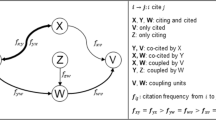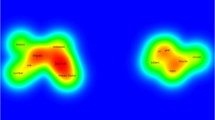Abstract
Traditional co-citation analysis has not taken the proximity of co-cited references into account. As long as two references are cited by the same article, they are retreated equally regardless the distance between where citations appear in the article. Little is known about what additional insights into citation and co-citation behaviours one might gain from studying distributions of co-citation in terms of such proximity. How are citations distributed in an article? What insights does the proximity of co-citation provide? In this article, the proximity of a pair of co-cited reference is defined as the nearest instance of the co-citation relation in text. We investigate the proximity of co-citation in full text of scientific publications at four levels, namely, the sentence level, the paragraph level, the section level, and the article level. We conducted four studies of co-citation patterns in the full text of articles published in 22 open access journals from BioMed Central. First, we compared the distributions of co-citation instances at four proximity levels in journal articles to the traditional article-level co-citation counts. Second, we studied the distributions of co-citations of various proximities across organizational sections in articles. Third, the distribution of co-citation proximity in different co-citation frequency groups is investigated. Fourth, we identified the occurrences of co-citations at different proximity levels with reference to the corresponding traditional co-citation network. The results show that (1) the majority of co-citations are loosely coupled at the article level, (2) a higher proportion of sentence-level co-citations is found in high co-citation frequencies than in low co-citation frequencies, (3) tightly coupled sentence-level co-citations not only preserve the essential structure of the corresponding traditional co-citation network but also form a much smaller subset of the entire co-citation instances typically considered by traditional co-citation analysis. Implications for improving our understanding of underlying factors concerning co-citations and developing more efficient co-citation analysis methods are discussed.










Similar content being viewed by others
References
Siddharthan, A., & Teufel, S. (2007). Whose idea was this, and why does it matter? Attributing scientific work to citations. In Proceedings of NAACL/HLT-07.
Bradshaw, B. (2002). Reference directed indexing: Indexing scientific literature in the context of its use. Evanston: Northwestern University.
Callahan, Alison., Hockema, Stephen., & Eysenbach, Gunther. (2010). Contextual cocitation: Augmenting cocitation analysis and its applications. Journal of the American Society for Information Science and Technology, 61(6), 1130–1143.
Chen, C. (2004). Searching for intellectual turning points: Progressive knowledge domain visualization. Proceedings of the National Academy of Sciences of the United States of America, 101(suppl 1), 5303–5310.
Chen, C. (2006). CiteSpace II: Detecting and visualizing emerging trends and transient patterns in scientific literature. Journal of the American Society for Information Science and Technology, 57(3), 359–377.
Chen, C., Zhang, J., Zhu, W., & Vogeley, M. (2007). Delineating the citation impact of scientific discoveries. In Proceedings of the 7th ACM/ IEEE-CS joint conference on digital libraries (pp. 19–28). Vancouver: ACM.
Chen, C., Song, I. Y., Yuan, X. J., & Zhang, J. (2008). The thematic and citation landscape of data and knowledge engineering (1985–2007). Data & Knowledge Engineering, 67(2), 234–259.
Elkiss, Aaron., Shen, Siwei., Fader, Anthony., Gunes, Erkan., David, States., & Dragomir, R. Radev. (2008). Blind men and elephants: What do citation summaries tell us about a research article? Journal of the American Society for Information Science and Technology, 59(1), 51–62.
Gipp, B., & Beel, J. (2009). Citation Proximity Analysis (CPA)—A new approach for identifying related work based on co-citation analysis. Proceedings of the 12th International Conference on Scientometrics and Informetrics (pp. 571–575). Leuvuen: International Society for Scientometrics and Informetrics.
Hirsch, J. E. (2005). An index to quantify an individual’s scientific research output. Proceedings of the National Academy of Sciences of the United States of America, 102(46), 16569–16572.
Liu, S., & Chen, C. (2011). The effects of co-citation proximity on co-citation analysis. In E. Noyons, P. Ngulube, & J. Leta (Eds.), Proceedings of ISSI 2011-The 13th International Conference on Scientometrics and Informetrics (pp. 474–484), Durban, 4–7 July 2011.
Marshakova, I. V. (1973). System of document connections based on references. Nauchno-Tekhnicheskaya Informatsiya, 2(6), 3–8.
Qiaozhu, M., & Xiang, Z.C. (2008). Generating impact-based summaries for scientific literature. Proceedings of ACL’08 (pp. 816–824). Columbus: ACL.
Nakov, P.I., Schwartz, A.S., & Hearst, M.A. (2004). In Citances: Citation sentences for semantic analysis of bioscience text. SIGIR 2004Workshop on Search and Discovery in Bioinformatics, Sheffield: SIGIR.
Nanba, H., & Okumura, M. (1999). Towards multi-paper summarization using reference information. The 16th international joint conference on artificial intelligence (pp. 926–931). Stockholm: IJCAI.
Nanba, H., & Okumura, M. (2005). Automatic detection of survey articles. The Research and Advanced Technology for Digital Libraries (pp. 391–491). Berlin: ECDL.
Qazvinian, V., & Radev, D. R. (2008). Scientific paper summarization using citation summary networks. Proceedings of the 22nd International Conference on Computational Linguistics (pp. 689–696). Stroudsburg: Association for Computational Linguistics.
Mohammad, S., Dorr, B., Egan, M., Hassan, A., Muthukrishan, P., Qazvinian, V., Radev, D., & Zajic, D. (2009). Using citations to generate surveys of scientific paradigms. Proceedings of Human Language Technologies: The 2009 Annual Conference of the North American Chapter of the Association for Computational Linguistics (pp. 584–592). Boulder: Association for Computational Linguistics.
Small, H. (1973). Co-citation in the scientific literature: A new measure of the relationship between two documents. Journal of the American Society for Information Science, 24, 265–269.
Small, H. (1979). Co-citation context analysis: The relationship between bibliometric structure and knowledge. Proceedings of the ASIS Annual Meeting. (pp. 270–275). Medford: Information Today.
Small, H. (2010). Interpreting maps of science using citation context sentiments: A preliminary investigation. Scientometrics. doi:10.1007/s11192-011-0349-2.
Small, H., & Greenlee, E. (1986). Collagen research in the 1970s. Scientometrics, 10(1–2), 95–117.
Small, H., & Sweeney, E. (1985). Clustering the science citation index using co-citations.1. A comparison of methods. Scientometrics, 7(3–6), 391–409.
Acknowledgments
Shengbo Liu is currently a visiting doctoral student at Drexel University. This research was supported by National Social Science Foundation of China (grant number 08BTQ025). An extended version of a paper presented at the 13th International Conference on Scientometrics and Informetrics, Durban (South Africa), 4–7 July 2011 (Liu S. & Chen C., 2011).
Author information
Authors and Affiliations
Corresponding author
Rights and permissions
About this article
Cite this article
Liu, S., Chen, C. The proximity of co-citation. Scientometrics 91, 495–511 (2012). https://doi.org/10.1007/s11192-011-0575-7
Received:
Published:
Issue Date:
DOI: https://doi.org/10.1007/s11192-011-0575-7




